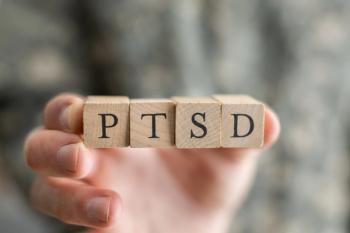
- Vol 35 No 3
- Volume 35
- Issue 3
PTSD in Late Life: Special Issues
PTSD in late life can result from trauma that occurred much earlier or can follow traumatic events that occurred for the first time in old age.
PTSD in late life can result from trauma that occurred much earlier or can follow traumatic events that occurred for the first time in old age. When trauma took place when the person was younger, PTSD in later life might represent the re-emergence after a period of extended quiescence or be the continuation of a chronic disorder experienced throughout adult life. DSM-5 criteria for the diagnosis of PTSD in older adults are no different from those for other age groups, with the exception of modified criteria for preschool children aged 6 years or younger.
DSM recommends using a “Delayed Expression” specifier when symptoms emerge more than 6 months after the index trauma, and the literature is replete with descriptions of older adults who experience the complete PTSD syndrome for the first time decades after the index trauma. Identifying chronic PTSD that has been present throughout most of adult life might be straightforward, although PTSD did not exist as a diagnostic entity when the older adult first developed the clinical syndrome. One Pearl Harbor survivor described his symptoms as “a non-stop movie playing in my head” that began soon after the attack. Decades later he received a diagnosis of PTSD and was subsequently treated with medications and psychotherapy.
Identification and treatment of PTSD in later life can present multiple challenges, starting with the unique aspects of the symptomatology of the disorder in older adults and from the issues with their treatment-seeking. For example, older adults might report somatic presentations over emotional-psychological symptoms. A higher intensity of hyperarousal symptoms, especially if the trauma occurred later in life, are reported while intrusive re-experiencing symptoms are not mentioned. Cognitive impairment and dementia-the risk of which is increased from a lifetime diagnosis of PTSD-might also interfere with the older adult’s ability to interpret and communicate symptoms.
RELATED CONTENT:
Another aspect of PTSD in later life that can be a factor in appropriate diagnosis and the decision about whether to institute treatment is that older adults frequently experience symptoms in numbers insufficient to cross the threshold of DSM criteria for a diagnosis of PTSD. Such trauma-related symptoms were observed to be at least as, if not more, common than threshold-level PTSD in clinical populations.1,2 Since the diagnostic significance of sub-threshold symptoms (ie, partial PTSD) had been unclear, clinicians had no clear understanding about the appropriate course of action for such symptoms.
Our research demonstrated that older adults with DSM-IV-defined PTSD at the time of initial assessment might have partial PTSD after a follow-up period of 3 to 6 months.2 Along similar lines, older adults with partial PTSD at initial assessment could receive a diagnosis of syndrome-level PTSD during follow-up. (These variable trajectories are summarized in the Figure.)
Furthermore, fluctuations in the symptom profile during the longitudinal course of PTSD were observed to be independent of other psychiatric comorbidities. This suggests that PTSD might be the rare DSM disorder that requires the presence of an external event(s) for diagnosis, but once manifest, it is no different from other psychiatric conditions (eg, mood or substance-use disorders) in having a relapsing and recurring course.2
Findings also indicate that older adults with PTSD have fewer friends and have greater difficulty in making ends meet.3 They are also more likely to feel stigmatized and think that their peers would view them negatively if they sought treatment for their symptoms. These observations have implications for the identification and treatment of PTSD in later life. However, there is little information regarding routine screening for or treatment of PTSD in older adults in the few available practice guidelines.4
It is important to point out that older adults who have experienced a traumatic event but who do not exhibit trauma-related symptoms have a better quality of life than those who have not experienced the adversity of trauma.2 Studying resiliency in this group could offer insights into how to optimize treatment to aid recovery.
Treatment planning
Treatment planning for patients with PTSD in later life presents its own challenges, which stem from a scant evidence base of interventions tested specifically in older adults. Few in the geriatric age group are accepted into randomized trials, and there are no published subgroup analyses from this population. The published literature on psychotherapies with proven effectiveness is only marginally better.5 However, older adults have been treated with the same interventions that have demonstrated efficacy in younger populations, and there is no evidence that these interventions have not been effective in the geriatric population.
Practice guidelines make no specific recommendations for the treatment of late-life PTSD, although the American Academy of Child and Adolescent Psychiatrists has guidelines for the pediatric population. Most guidelines could benefit from updates and inclusion of recent literature-with the notable exception of the Veterans Affairs/Department of Defense (VA/DoD) guidelines, which were updated in October 2017.6,7
A number of therapeutic interventions show promise, although the practicality of their use in older adults is yet to be explored. Both medications and various types of trauma-focused psychotherapies, especially those that have been manualized, are available for use. The ease with which these interventions can be employed, based on the strength of the evidence for their usefulness, is summarized in the Table.
If resources are available, it might be optimal to combine psychotherapy and psychopharmacological interventions. At least one trial in survivors with PTSD from the World Trade Center attack demonstrated that treatment involving psychotherapy combined with medication was superior when compared with the same therapy along with placebo.8 Assessment for other psychiatric and medical disorders that are commonly comorbid with PTSD in later life is strongly encouraged, as is the potential use of a severity or symptom rating scale to document any improvements.
Psychopharmacology
Sertraline and paroxetine have FDA approval for the treatment of PTSD; the VA/DoD guidelines also recommend either fluoxetine or venlafaxine as first-line monotherapy options. Of these 4 agents, paroxetine and venlafaxine have noticeable anticholinergic adverse effects and fluoxetine has a long half-life and significant drug-drug interactions, which suggests the need for monitoring if any of the medications besides sertraline are used in older adults.
Prazosin, an alpha-adrenergic blocker, has shown benefits for PTSD symptoms of re-experiencing (eg, nightmares) and an independent beneficial effect on sleep quality in multiple trials. However, in spite of the positive results, the VA/DoD guidelines state that the data are inconclusive and make no recommendation for the use of prazosin (either as monotherapy or for augmentation) because a large multicenter trial, the results of which are suspected to be negative, remains unpublished. Prazosin has the additional effect of lowering blood pressure and can result in significant orthostatic hypotension. The lore among clinicians is that prazosin is helpful; close collaboration with a primary care physician/geriatrician to first lower the dose(s) of existing antihypertensive medications is recommended before initiating prazosin.
Clinical trials with multiple other classes of medications (eg, mood stabilizers, D-cycloserine) have been attempted with inconsistent results. Based on a risk-to-benefit analysis, it is best to avoid trials of second-generation antipsychotics (especially risperidone) even though there might be instances when psychotic symptoms, rarely present with PTSD, might improve. Similarly, monotherapy with benzodiazepines should be avoided even though they typically offer immediate relief from anxiety in the short term. Not only do benzodiazepines present a host of risks of their own and impair cognition, but they are also likely to interfere with habituation and learning that might occur through psychotherapy.
Psychotherapy
Prolonged exposure therapy, which involves emotional processing of the traumatic events, is the most extensively researched psychotherapeutic intervention for PTSD. The evidence for other similar therapies such as cognitive processing therapy, eye movement desensitization and reprocessing, and cognitive behavioral therapies specific for PTSD is robust. The VA/DoD practice guidelines also include brief eclectic psychotherapy, narrative exposure therapy, and written narrative exposure, but almost all the evidence comes from trials in younger adults.6
The evidence for the “trauma-focused” psychotherapies for older adults is much less extensive. Nonetheless, case studies of prolonged exposure for older adults without cognitive impairment were among the earliest psychotherapeutic interventions reported, and such therapy seemed to be well tolerated without any adverse effects on cardiac comorbidities or treatment dropout. All of the exposure-based psychotherapies have shown at least some improvement for all domains of PTSD symptoms, and the benefits have persisted after the therapy was stopped.5
Experimental approaches
Although there are more treatment options now than in 1980, when PTSD was formally recognized as a psychiatric condition by DSM-III, many persons with PTSD experience only partial relief of their symptoms. A number of alternative treatments have been explored, and adjunctive use of mindfulness and meditation-based treatment approaches have shown some incremental improvement for PTSD and any accompanying depression.8,9 Small samples and open-label trials limit conclusions as to when and for whom these interventions might be recommended.
The Multidisciplinary Association for Psychedelic Studies (MAPS), a non-profit research and educational institution announced that the FDA had recently granted methylenedioxymethamphetamine (MDMA)-assisted psychotherapy a Breakthrough Therapy designation-thereby paving the way for a phase 3 trial.10 Conversely, there is no evidence that marijuana is beneficial for PTSD, and the American Psychiatric Association does not support its use. It is important for clinicians to be aware of the risks and harm, including exacerbation of psychiatric illness, even as 28 states and the District of Columbia now have legislation allowing for the use of cannabis products for PTSD.11
Conclusion
It is important to note that while there are no published studies of late-life PTSD using DSM-5 criteria and no medication trials specifically in older adults, interventions that are useful for PTSD in other age groups can be used in later life and based on clinical experience are well tolerated. Manualized, trauma-focused psychotherapies such as prolonged exposure have the greatest evidence. Antidepressants, especially SSRIs, have potential benefit as well. Nonetheless, there is much that remains to be learned about late-life PTSD.
Acknowledgement-I am grateful to Avron Spiro, III, PhD, who reviewed this manuscript.
Disclosures:
Dr. Chopra reports no conflicts of interest concerning the subject matter of this article.
References:
1. Durai NL, Chopra MP, Coakley E, et al. Exposure to trauma and posttraumatic stress disorder symptoms in older veterans attending primary care: comorbid conditions and self-rated health status. J Am Geriatr Soc. 2011;59:1087-1092.
2. Chopra MP, Zhang HM, Pless Kaiser A, et al. PTSD is a chronic, fluctuating disorder affecting mental quality of life in older adults. Am J Geriatr Psychiatry. 2014;22:86-97.
3. Pless Kaiser A. Seligowski A, Spiro 3rd A, Chopra M. Health status and treatment-seeking stigma in older adults with trauma and posttraumatic stress disorder. J Rehabil Res Dev. 2016;53:391-402.
4. Forbes D, Creamer M, Bisson JI, Cohen JA, et al. A guide to guidelines for the treatment of PTSD and related conditions. J Trauma Stress. 2010;23:537-552.
5. Cook JM, McCarthy E, Thorp SR. Older adults with PTSD: brief state of research and evidence-based psychotherapy case illustration. Am J Geriatr Psychiatry. 2017;25:522-530.
6. VA/DoD Clinical Practice Guidelines for PTSD.
7. American Psychiatric Association. Practice Guidelines for the Treatment of Patients With Acute Stress Disorder and Posttraumatic Stress Disorder. Arlington, VA: American Psychiatric Publishing, Inc; 2004. Also available at:
8. Schneier FR, Neria Y, Pavlicova M, et al. Combined prolonged exposure therapy and paroxetine for PTSD related to the World Trade Center attack: a randomized controlled trial. Am J Psychiatry. 2012;169:80-88.
9. Hilton L, Maher AR, Colaiaco B, et al. Meditation for posttraumatic stress: systematic review and meta-analysis. Psychol Trauma. 2017;9:453-460.
10. Multidisciplinary Association for Psychedelic Studies (MAPS). A Phase-3 Program of MDMA-Assisted Psychotherapy for the Treatment of Severe Posttraumatic Stress Disorder (PTSD).
11. O’Neil ME, Nugent SM, Morasco BJ, et al. Benefits and harms of plant-based cannabis for posttraumatic stress disorder: a systematic review. Ann Intern Med. 2017;167:332-340.
Articles in this issue
over 7 years ago
Timolol Does Not Cause Psychosisover 7 years ago
QT Prolongation and Antidepressantsover 7 years ago
Molly’s Game: Poker Hospital and Pathologic Gamblingover 7 years ago
The Jugglerover 7 years ago
Advantageous Adages in Psychodynamic Psychotherapyalmost 8 years ago
Lies, Damn Lies, and StatisticsNewsletter
Receive trusted psychiatric news, expert analysis, and clinical insights — subscribe today to support your practice and your patients.














